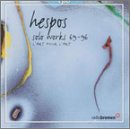| All Artists: Hans-Joachim Hespos, L'art pour l'art Title: Hespos: Solo Works ('69-'96) Members Wishing: 0 Total Copies: 0 Label: Cpo Records Original Release Date: 1/1/1969 Re-Release Date: 4/15/2003 Genres: Special Interest, Classical Styles: Chamber Music, Historical Periods, Classical (c.1770-1830) Number of Discs: 1 SwapaCD Credits: 1 UPC: 761203989027 |
Search - Hans-Joachim Hespos, L'art pour l'art :: Hespos: Solo Works ('69-'96)
 | Hans-Joachim Hespos, L'art pour l'art Hespos: Solo Works ('69-'96) Genres: Special Interest, Classical |
Larger Image |
CD Details |
CD ReviewsProduce sounds in an extrmely diverse fashion-SOLOS scarecrow | Chicago, Illinois United States | 02/03/2005 (5 out of 5 stars) "Hespos has been kicking around the avant-garde in Germany, well Europe for quite some time now, the early Sixties.He has written incredible swabs mounds of music, his musical language reamins innovative,original,if that word has any context anymore, this is not music to augment the cash box, it is music about timbre and where it goes, how it develops or becomes abandoned, what violence does to timbre, what silence does to timbre, and differing contexts, how a musician responds to making timbre, in fact this music mixes itself cross-fertilizes itself with other disciplines as theatre, for it is difficult to think of the music he creates, that is created from his music without the actor, the actress, So his scores are more like expressive procedures, grids for timbral display, and directions, coaching on how to discover timbre, on how to create art, make art anyway you can, but be interesting. It is assumes in all his work that the full spectrum of timbre, extended techniques are utilized as commonplace, nothing is extended if what is extended is considered the norm, and that's where his music begins, Take "duma" (1980) for alto flute, it begins like an electronic sound, like a gentle motor turned on, we dicover it is a flute harmonic, two tones sustained, then we hear something that resembles water gently coming up from the water drain, or that hasn't quite gone down yet completely. The work proceeds with other "narratives" at work,locomotive tongueing, vocal chatter, spitting into the flute,and then plaintive lament kind of tones held, lonely tones, mixed with slapping the keys,screams at times, percussive effects/affects. The "splash" is a bit more exciting for contra bass and percussion, lots of silences here, but the two musicians take off at times, not over taxing what they got,lots of rhythm dovetailing into each other, fast and it holds one's interest,there is a kind of pointillism still at work here where tones can be tossed anyplace and at anytime, but Hespos finds another contexts for this serious sounding avant-garde stuff, he keeps, well they keep the momentum going. Many of Hespos works are simply written WORD instructions, not real music written on five lines, there is that but he utilzes graphic notation, little black dots, graphics where it is suppose to sounds like ti looks."kitara" is that a another solo, more silences,tapping the body of the instrument, barely audible most of the time, which is the reason why one needs to SEE this music played, there is always a break of silence, with violence in Hespos, and we get that, tones coming from all directions, harmonics, plucked.. A good time for a Hespos piece is about 5 to 6 minutes, any longer and you quite rightly feel the work draining you into a transgressive situation. Hespos has within the last ten years has brached arborescencednced himself out into more theatre where he belongs, as I said, and "opera", tones and words sung and spokem it is not opera."monske" is a lotta fun for mobile tympani, you should take advantage of the fact that tympani drums are on wheels, and in this CD you hear wonderfully the rolling noises which are simply compelling, part of the piece.There are some whipp cracks as well, perhaps the tympani is a "bull" of sorts, great idea for music."leija" the harp solo is ugly-beautiful, where the lower strings are allowed to vibrate against something, the adjacent string or the fingernail, and the tones sometimes are pulled out of tune, it has a "mystery" about it,an attitude as well, playful I would have loved to hear Harpo Marx play this piece."picc" fpr piccolo recorder is "canary-like" more haunting like sounds, perhaps a nocturne here, and the vpoice is utilzed, the voice here representing the basso regions of the piece, another stroke of genius to force this situation.the voice recites fast fragments of non-sense syllables. Again Hespos is playful,light, music the avant-garde for children."cang" is for cymbalom solo,the "hammer piano" prevalent in Eastern Europe,this is a piece you simply wait for something to happen, there are noises occuring but barely audible, the inside of the piano box is utilzes here as well."very different pitches,", "poundings", beginning hardly,observably,extremely powerfully swinging remains very narow, intensive hardly moved almost simultaneous, excessively swift. . . " Hespos instructs. Other times the work sounds like the instrument was dropped. Lastly "Z , , , " is for a pianist but the entire ensemble joins in, in a kind of theatrical non-narrative,lots of nonsense vocables.Solos are where Hespos bears fruit,one-on one."
|
